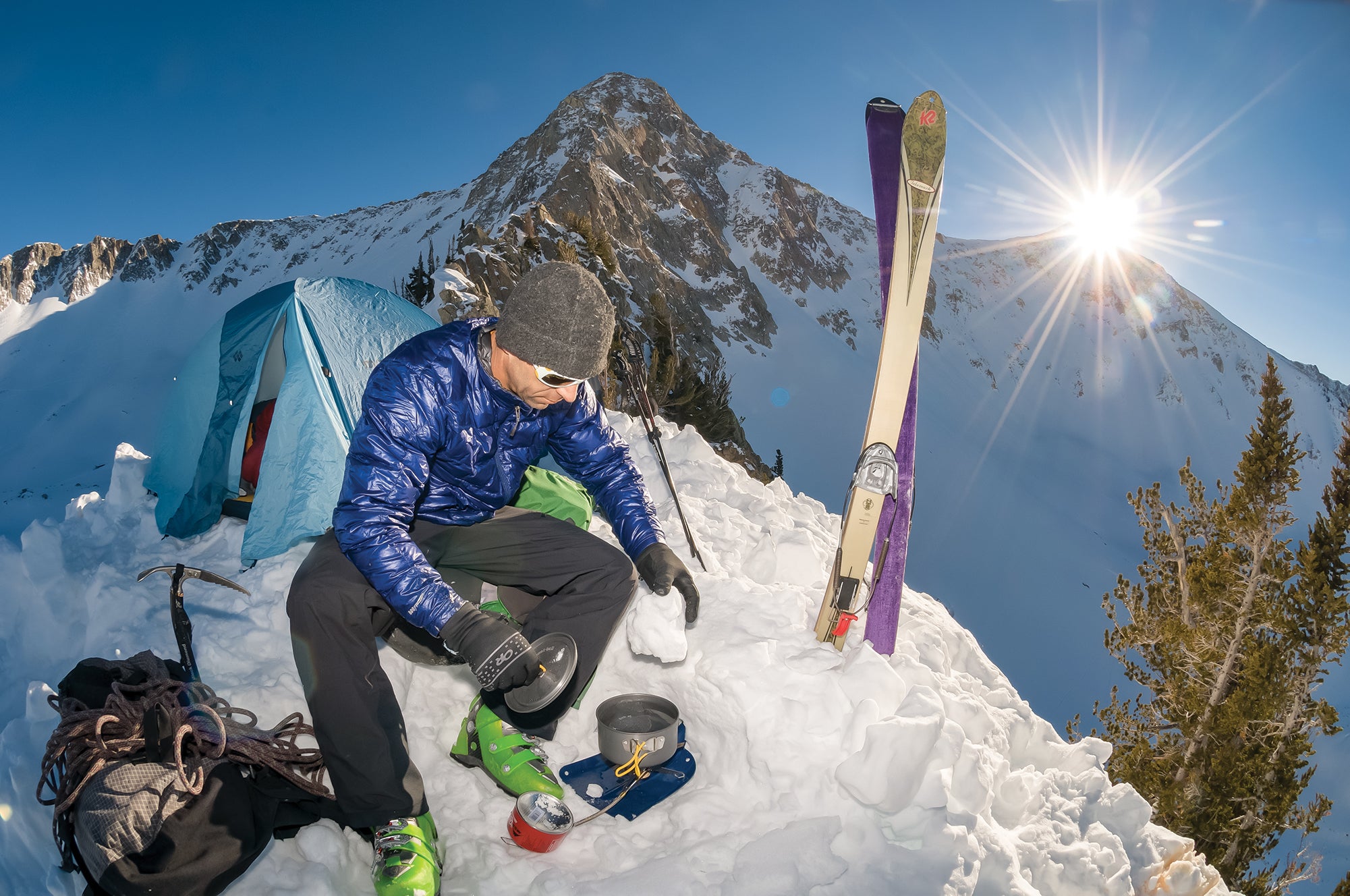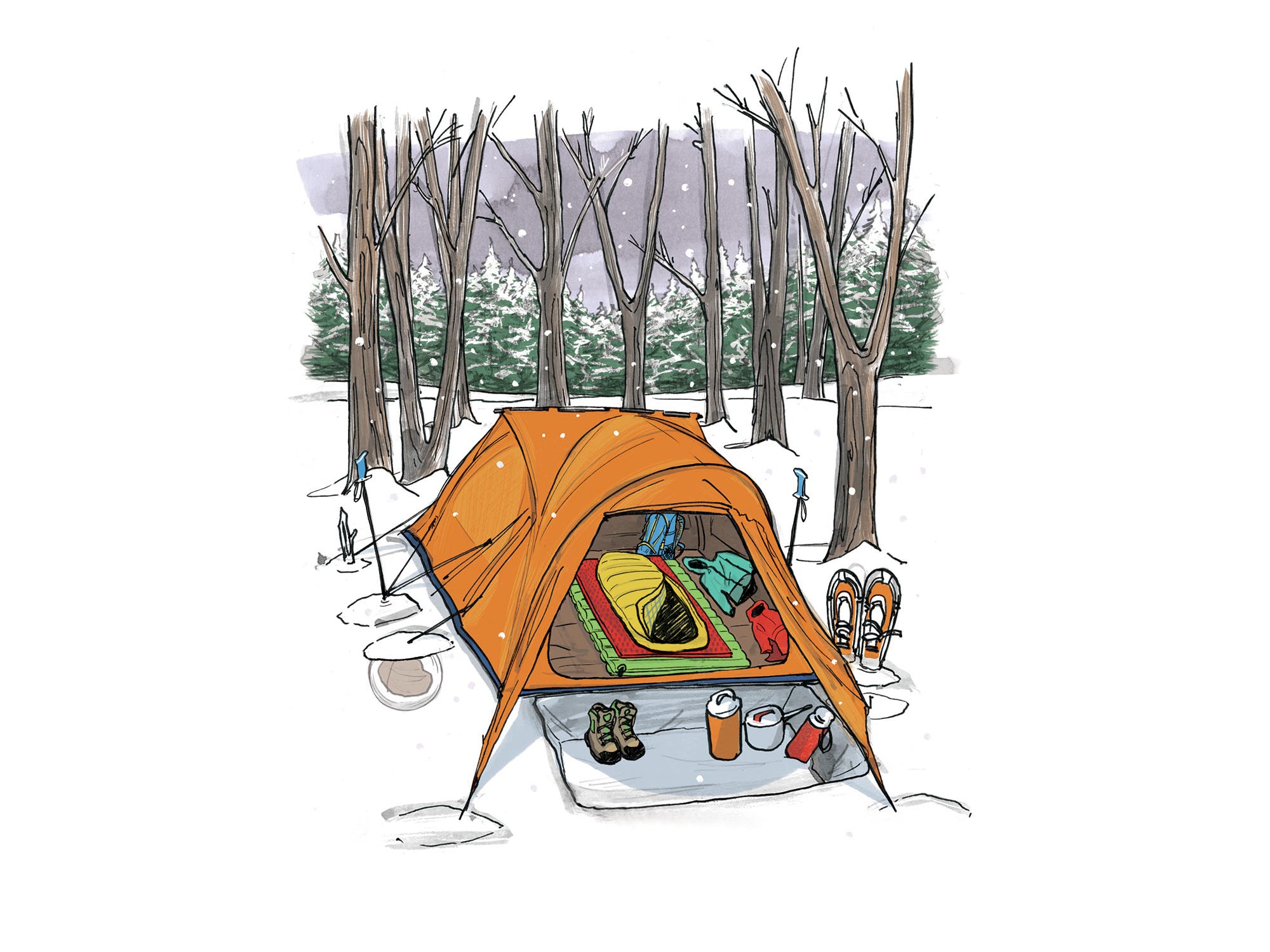How to Camp in Comfort This Winter

'Kennan Harvey'
Pack precisely.
Adapt your kit to where you’re camping. For wetter climates (like the Pacific Northwest) you’ll want Gore-Tex layers, waterproof gloves, and a heavy-duty synthetic or hydrophobic down sleeping bag to help manage moisture. For drier climates (like the Colorado Rockies) pack softshell pants and a down bag. Always carry an extra pair each of warm socks, gloves, toe warmers, and spare batteries or a charging block (cold drains power).
Choose the right shelter.
You don’t need an expedition-style tent to go winter camping, but you’ll want one that has limited mesh on the lower half to avoid snow buildup inside. Look for closeable vents up top to combat interior condensation. (In general, double-walled tents are the warmest, driest options.)
Read snow reports.
Be sure to check both the avalanche and weather forecasts in the days and hours leading up to your trip. Consider rescheduling if the prediction includes blowing winds, overnight lows that your gear isn’t rated for, and powerful storms. Take an avalanche safety class before venturing into mountainous terrain.
Cook in comfort.
In deep snow, dig out a small area to protect you from wind while cooking (about 6 by 8 feet, depending on group size). Place your stove on top of a rock, pot lid, or foil-covered cardboard to prevent your snow counter from melting. Never cook inside your tent—carbon monoxide kills, even in a well-ventilated shelter (cooking in the vestibule is OK, but be extra cautious to maximize airflow and avoid igniting your tent).
Fill up on fats.
Your body burns more calories in winter to stay warm—you’ll find yourself craving rich foods like butter and cheese. Bring along simple meals with high calorie counts and fat content, and plenty of snacks and hot drinks. Aim for a daily intake of 3,000 to 5,000 calories. Seasonal bonus: Perishables won’t spoil.
Resist the freeze.
The biggest chore while winter camping is melting snow for water. Choose an area to collect clean snow; make sure it’s at least 200 feet away and uphill from where you plan to use the bathroom. Place a pot with an inch or two of water on top of a stove before adding the snow to avoid “burning” it—when it evaporates before it turns to liquid—or scorching your pot. The snow’s volume will reduce by up to two-thirds depending on water content, so bring plenty of fuel. Fresh snow rarely contains bacteria, but boiling to sterilize is the best guarantee for safe drinking water. Create cubbies in your kitchen with a snow “door” to store your stove and pot. Snow acts as an insulator, keeping water from freezing.
Say bye to bladders.
Leave the water reservoir at home and pack bottles instead. Store them wrapped in layers inside your pack to avoid freezing (or spring for an insulated bottle). If they freeze shut, dip the tops in your cookpot. Begin melting snow when your bottle is half empty so you don’t run out.

Create a Cozy Camp
A good sleeping setup can mean the difference between safety and suffering.
Before you bust out the tent, stomp down a platform to avoid lumps, bumps, or sinking—if it’s exceptionally windy, dig down in the snow a few feet first. Skis are helpful here, but snowshoes will also do the trick. Afterwards, let the platform set, or sinter, for up to 30 minutes (depending on snow and weather conditions) before pitching your tent.
Set up camp away from avalanche paths and preferably in a sheltered, treed area.
Sleep in your baselayers and camp socks to maximize breathability and warmth. Don’t wear your Gore-Tex to bed—if you’re still cold, layer up with fleece.
Store your backpack between the foot of your sleeping bag and the tent walls. Put your Gore-Tex layers beside your sleeping bag to protect against moisture transfer.
If you have a three-season pad, combine it with a closed-cell foam one. Always put the pad with the higher R-value closer to your body.
Build deadman anchors by tying ropes to deadfall branches or rocks and burying them. Trees, ski poles, and other objects also work well. Use a slipknot for snow anchors or you’ll be digging to retrieve your guyline.
Keep your essential gear and clothing warm while you sleep: Tuck your batteries, cell phone, lighter, boot linings, and fuel canister in your sleeping bag to prevent them from freezing.